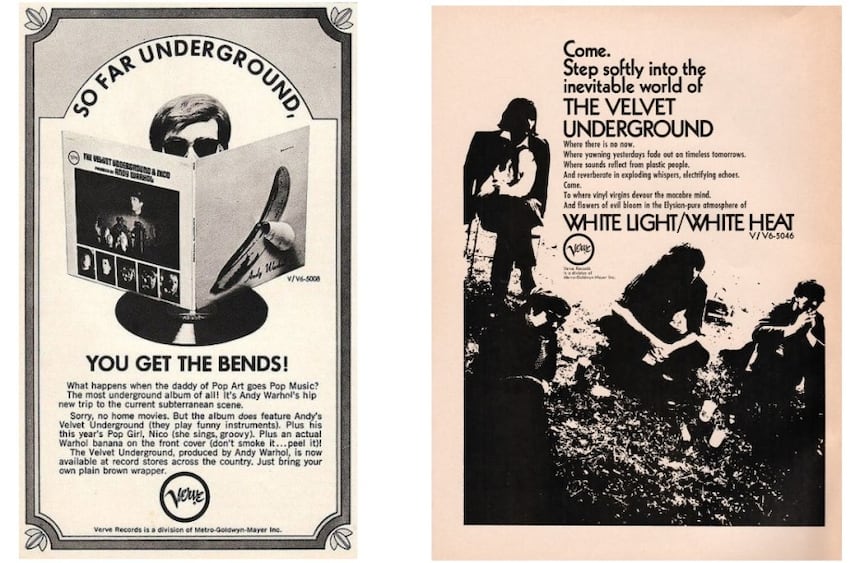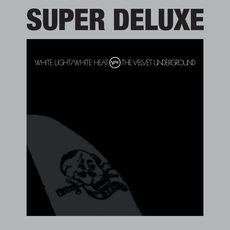The story is that Brian Eno said it first: only a thousand people bought the Velvet Underground’s first album, but each of those thousand people formed a band. That anecdote perhaps gives some sense of the importance of the outfit put together by Lou Reed and John Cale at the end of the 1960s. The two men met in 1964. Lou found his first job as a songwriter for the Pickwick label in New York. There, he met a young Welshman who had come to Manhattan to study with experimental composer La Monte Young. The two men got to know guitarist Sterling Morrison and the drummer Maureen Tucker: Velvet Underground was born. Its name started to circulate through the small scene of Manhattan’s Lower East Side, until it reached the ears of Andy Warhol, who would become the group’s mentor. Creator of the famous banana record sleeve for the group’s first album, which came out in March 1967, he was also the guru of the Factory, who brought the model and singer Nico to the quartet for several numbers. Andy Warhol Presents The Velvet Underground & Nico is a bottomless pit, a curio where Lou Reed’s DNA of animal rock ‘n’ roll, folk and pop collides with the experimental leanings of Welsh intellectual John Cale and the zombie voice of the beautiful Christa ‘Nico’ Päffgen. At the outset, a superb snapshot of avant-garde New York in the late 1960s, which sees distortion, sex and violence put to daring use in a descent into hell as decadent as it is unflinching.

The following year, White Light / White Heat which arrived in January 1968, turned up the heat further. "No-one listened to it. But there it is, forever - the quintessence of articulate punk. And no-one goes near it..." Lou Reed, humble as ever. Very humble, but, as it happens, pretty spot on. Words he spoke a few weeks before kicking the bucket... Avant-gardist, noisy, abusing a certain tradition without wanting to wipe it out, White Light / White Heat is clearly the one and only album made by Lou Reed AND John Cale without any contributions or colourations from outside. Because as fine as it was, the first, banana album of the year prior bore the fingerprints of Andy Warhol (and it was he who brought Nico on board, overriding Lou Reed's objections). So White Light / White Heat is also a snapshot of a wrestling match between two musicians with contrasting visions and preoccupations. Lou Reed loved blues, soul, 1950s rock, doo-wop and free jazz, while John Cale preferred contemporary and experimental music. We know the rest: the austere Welshman left the group to pursue a solo career after the recording of this second album... So we are left with this oddity, White Light / White Heat at whose heart sparkles the 17-minute electric orgy of Sister Ray and the black humour of The Gift as read by Cale. From the off, these were six tracks that would shake rock to its foundations with their stylistic and formal radicalism, like the journeys into hell which would be the hallmark of the greatest indy-rock terrorists of the years to come, from Sonic Youth to My Bloody Valentine...
So Lou Reed's ego and its urgent imperatives sent John Cale hurrying for the exit; and the soberly-named third album The Velvet Underground, functioned as a kind of launchpad for a solo Lou with stripped-down ballads and bare-bones, binary rock... Forget White Light / White Heat's torrent of electricity: it's ballads like Candy Says and Pale Blue Eyes that light up this record, whose production values might be called pared down, to say nothing of skeletal... That Lou Reed is a rock’n’roll animal is made clear by What Goes On and Beginning To See The Light, and he loves to remind his listeners of his fascination with the avant-garde, as he does with his experimental The Murder Mystery... The final pirouette of this masterpiece is the arch-cult, naïve ballad After Hours, sung by drummer Moe Tucker.
The first banana album is worshipped, the experimental White Light / White Heat is lauded and the third, self-titled, album is venerated. But the fourth and final studio work from Velvet Underground is often neglected, or even just forgotten... Released in 1970, Loaded nevertheless remains a real masterpiece, even if its recording, like its casting, could not have been more chaotic. After all, the work contains a good number of magisterial songs (it's here that the hits Sweet Jane and Rock’n’Roll appear for the first time), in the mould of Who Loves the Sun, which opens the album like a sunrise (makes sense, given the title...) and a lot of pop. We are a long way here from the early darkness of Andy Warhol's Factory... On a track like I Found A Reason, there is a light-heartedness more reminiscent of the Beach Boys. But Lou Reed would still storm out before the release of this record, and Doug Yule, who also sings on some tracks, would finish it off. Even Moe Tucker only drums on a few songs. Regardless, Loaded is a treasure, a major album in the history of rock'n'roll.
Years passed, studded with brilliant solo albums from Lou Reed and John Cale, who were no longer on speaking terms... Until in 1990, the two men not only re-established a dialogue, but came back to the studio to record a superb album in honour of their friend Andy Warhol: Songs For Drella. When the Fondation Cartier dedicated a large exhibition Jouy-en-Josas to the Pope of Pop Art, who had passed away in 1987, Lou Reed and John Cale played a few songs from the album at its opening. They were joined on stage by Sterling Morrisson and Moe Tucker, and proceeded, to general amazement, to perform a version of the classic Heroin! This brief reunion sparked a real reunion, and the Velvet Underground arose from its ashes to play numerous concerts in Europe, and the first part of a U2 tour. A live album was even recorded in Paris (Live MCMXCIII). But things didn’t stay patched up for long: Lou Reed and John Cale were soon back at loggerheads. The death of Sterling Morrison on 30 August 1995 at the age of 53 signalled the demise of the Velvet Underground. On 27 October 2013 it was joined by Lou, who was carried away by liver cancer at the age of 71.

















